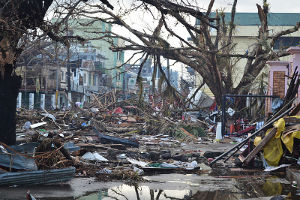Climate change and its impact on emerging countries
Super Typhoon Haiyan, early November 2013 in the Philippines, has revived the debate on climate change and its impact on poor countries.
 Tacloban, Leyte island, philippines © Trocaire, CC BY 2.0 Tacloban, Leyte island, philippines © Trocaire, CC BY 2.0 |
The World Bank statistics show that at the global level, the damages due to natural catastrophes increased from 50 to 200 billion USD per year between 1980 and 2012. The total cost of the cumulative damages during this period amounted to nearly 3 800 billion USD, while the number of the dead reached 2.5 million people. Three-quarters of these human and material losses are accounted for by extreme weather events.
The German reinsurer Munich Re noted that the number of special events occurring in East Asia between 1980 and 2012 went fourfold. In 33 years, the total economic losses in the region reached 700 billion USD, only 11% of which were supported by insurers, that is 76 billion USD. Floods account for 56% of economic losses and 30% of insured losses.
Impact of climate change on emerging countries
The situation of emerging countries is worrying, with poor or middle-income countries being the hardest-hit by this kind of events. The price paid by these countries is huge. In economic terms, it is estimated that natural catastrophes cost countries 2.9% of their GDP, compared to only 0.8% for developed countries.
According to a study of the British firm Maplecroft, the climate change Vulnerability Index (CCVI), which identifies weather hazards in 193 countries according to their impact on the population and on economic activity by 2025, is hardly reassuring.
The study underlines that major emerging countries and the new economic powers, including India and China are among the 67 most vulnerable countries to natural disasters. In the next ten years, they would accounted for almost 31% of global GDP (compared to 21% currently), that is, more than 40 000 billion USD. In addition, 64% of the global population, or 4.5 billion people now live in the most vulnerable countries, a number poised to reach 5 billion by 2025.
Impact of climate change on Africa and the Middle East
The Climate Change Vulnerability Index has ranked six African countries among the 10 most exposed ones. They are: Guinea-Bissau, Sierra Leone, South Sudan, Nigeria, the Democratic Republic of Congo and Ethiopia.
Flooding and droughts are the most feared weather events, with West Africa and the Sahel being often the hardest-hit by these disasters.
From July to November 2012, Nigeria has been facing severe floods that resulted in the loss of 500 000 barrels of oil per day, that is one-fifth of the country’s total production. Djibouti was, for its part, affected by a severe period of drought between 2008 and 2012, a scourge that caused an annual contraction of its GDP of almost four points.
In recent years, the Middle East also experienced a significant increase in the number of natural catastrophes. Floods and sand storms have accounted for most of the frequent events, causing human losses and important material damages. Most affected countries by these weather events are Yemen, Saudi Arabia, Egypt and Lebanon.
In the Africa and Middle East region, Algeria, Turkey, and Iran remain the most threatened countries by the occurrence of devastating earthquakes.
Related articles :